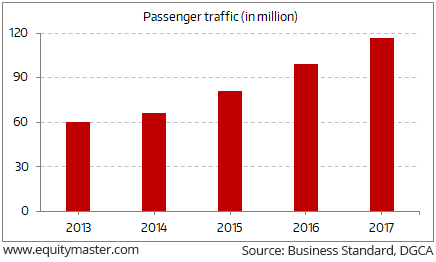After opening the day in green, share markets in India witnessed choppy trading activity throughout the day and are presently trading flat with a positive bias. Sectoral indices are trading mixed with stocks in the IT sector and stocks in the capital goods sector trading in green. While stocks in the realty sector are trading in red.
The BSE Sensex is up by 30 points (up 0.1%) and the NSE Nifty is trading up by 18 points (up 0.2%). Meanwhile, the BSE Mid Cap index is trading up by 0.1%, while the BSE Small Cap index is trading down by 0.3%. The rupee is trading at 65.17 to the US$.
In news from stocks in the aviation sector. According to data from the Directorate General of Civil Aviation (DGCA), domestic air traffic was up by over 24% in February, compared to the same month last year.
Indian carriers flew 10.7 million passengers in the past month, up from 8.6 million in February 2017,
All key scheduled carriers flew their planes with more than 80% seats full. SpiceJet maintained its pole position in terms of load factor at 96.3%, followed by IndiGo at 91.8% despite problems with its Airbus 320 Neo aircraft.
Vistara was a surprise third, flying its planes with 91.2% seats full, the highest ever for the airline that flies its planes in a three-class configuration: economy, premium economy and business.
IndiGo remained the market leader, flying 39.9% of the industry passenger traffic. Jet Airways came in next with 16.8%, followed by national carrier Air India with 13.2%.
Indian Aviation Spreading its Wings

Air travel has recorded double-digit growth for 40 consecutive months, thanks to low fares, the addition of new flights/destinations, and overall growth in the economy.
What’s foreseeable for India’s aviation traffic in 2018 is some pressure on the back of the consistent rise in crude oil prices. Earlier this month, Brent crude oil briefly breached US$70 per barrel and touched its highest level since December 2014. Crude prices have been driven up by production curbs in OPEC nations and Russia, as well as by robust demand on the back of healthy global economic growth.











Leave A Comment